Apologies to Johnny Sweatpants
Wednesday, October 17th, 2007 • Horrorthon Posts
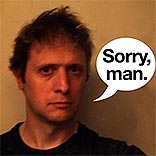
I didn’t mean to piss you off! Sorry about all that. Peace bro.
Wednesday, October 17th, 2007 • Horrorthon Posts

I didn’t mean to piss you off! Sorry about all that. Peace bro.
Sunday, October 14th, 2007 • Horrorthon Posts / Horrorthon Reviews

You still don’t understand what you’re dealing with, do you? A perfect organism. Its structural perfection is matched only by its hostility. I admire its purity: a survivor, unclouded by conscience, remorse or delusions of morality.
1979 (*****)
This movie is perfect. It is flawless. (Actually it has one flaw; see below.) As I continue my “Masterpiece Series” I find the rhetorical challenge gets worse and worse: how can I “review” these things? I went a little overboard with Psycho so I promise to try to keep this post clean and to the point (much like the movie).
1) The Monster Movie
What’s amazing about Alien is that there’s nothing to it, really. It’s a monster movie. The monster kills the people, one by one. It’s what one critic calls a “cast-attrition thriller”; the template children learn as “Ten Little Indians.” It’s an extremely scary monster; maybe the scariest ever. One look at it makes every victim (except one) freeze in place from pure ice-cold terror. And when it kills you, it’s a horrible death. (Veronica Cartwright’s extended, multiple-stage scream gives me goosebumps every single time I watch this, and I’ve watched it as many times as some people have watched Friends.) Additionally (as befits post-Exorcist, post-Hammer movie examples of the form) the monster is mysterious, unpredictable. It changes its size and shape. It ends up in places you don’t expect (like, inside you, or, later, inside the vehicle you thought you were using to get away from it) and then jumps out when you’re not ready for it. Sometimes it doesn’t kill you (according to the extended release or the deleted scenes on the disc) but does something even worse; something so bad that it makes you beg to be killed (“Quickly!”) when they eventually find you. You can’t outrun it; you can’t hurt it (and don’t want to, since it bleeds acid that sprays all over the place and melts through sheets of steel); you can’t out-think it any more than you can “out-think” a lion that’s stalking you across the Serengetti plain; and it will keep coming after you until you finally, desperately blow it up, slightly more than one minute before the end credits roll.
That’s it: that’s Alien. That’s all there is to it. Over the years, director Ridley Scott has enjoyed confounding critics and interviewers by insisting that Alien has “no theme; no message; no inner meaning.” He scoffs at the idea of character development: “Who’s got time for ‘character development’ with that thing coming after you?” The seven characters (of whom one is a traitor, of course) are stock types, and each meets a fate completely consistent with his or her basic identity: the dumb guy dies because he makes a really stupid mistake; the brave guy (“I’ll volunteer to be in the first group to go out”/”Yeah, that figures”) sticks his face right into it; the panicky woman freezes and can’t move when she faces it; the bad leader makes a wrong turn at a crucial moment and pays the price about twenty seconds later; the headstrong guy rushes right at it and buys the farm; etc. etc. The screenplay gives each person only one name and (famously) doesn’t even bother to distinguish between male and female characters, stressing that each could be played as a man or a woman without affecting the story in the least. (The fact that the most heroic character is played by an actress was apparently controversial during production but allegedly Scott insisted.) You never get the slightest hint of background or detail about who these people are. They are seven “types” with single names, trapped in a vast enclosed space with the worst monster ever. Even if you don’t understand English, you’ll still be able to follow the entire story and have the wits scared out of you.
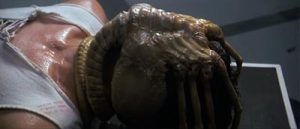
That’s the whole point: there is absolutely nothing in the movie that represents an attempt to “improve” or “deepen” the idea. The monster has no “motivation” at all (especially with the removal of the scene I mentioned above, which begins to explain why the Alien does what it does). Nobody is “confronting their past” or “dealing with their demons” or anything like that. There is no “magic,” no secret key or lore or scroll or Bible verse or incantation or talisman; the alien ultimately bites it because (like all matter in the universe) it’s susceptible to a fusion reaction. There is no “looking within yourself” or “believing” or “using teamwork” or anything like that. The absolute brilliance, the stunning achievement of the movie is to strip away every possible element that could be seen as “improving” or “explaining” the nightmare. It is what it is, boldly, without apology. There’s nothing to it at all, except that it’s perfect.
2) The Sci-Fi Movie
My job becomes more difficult here. because this is Horrorthon, but Alien is not just a monster movie: it’s a science fiction movie, and that’s just a completely different discussion than the one I outlined above. I mentioned that the characters and the monster are trapped in a vast, enclosed space. That would be Weyland-Yutani Commercial Towing Vehicle U.S.C.S.S. Nostromo (registration number 180924809), a cathedral-sized private-sector “tugboat” spacecraft hauling twenty million tons of unspecified mineral ore back to earth from somewhere out in deep space, far enough away that the small crew spends the three year journey in suspended animation; the non-sentient onboard computer, “Mother,” wakes them when they get close to their destination. Mother is also programmed to interrupt the journey “should certain conditions arise,” which is how the story begins: obeying perfect Aristotelian Unity of Time, the camera prowls through the freezing, deserted corridors of Nostromo and glides into the control room at the exact moment that the ship comes in range of an unidentified signal (erroneously identified as a “distress call” but ultimately decoded as a “warning”) that awakens the ship’s systems and triggers the procedure for reviving the crew.
I mentioned how remarkably simple and clean the “monster movie” portion of Alien turns out to be. The “science fiction movie” elements are completely different: they are sophisticated to a degree that’s unmatched anywhere except Star Wars and (possibly) Kubrick’s 2001: A Space Odyssey (which this movie enthusiastically emulates). There’s too little embellishment to the horror elements of the narrative (as I explained) to make critics or film students happy; but there’s way too much sci-fi sophistication. Nobody except Kubrick has ever gone to this much trouble to create a space-travel environment for a story. You don’t have to pay any attention if you don’t want to, but Nostromo and its personnel, equipment and technology are worked out in staggering detail. Dan O’Bannon, the original screenwriter, had a background in computer technology (and did some graphics work on the first Star Wars); Ridley Scott is a technical genius who learned his craft making television commercials and who personally storyboarded the whole movie; Ron Cobb (hired by Scott) was an industrial illustrator who developed the design of the Nostromo’s world down to every hydraulic chair mount and wall symbol (they actually make sense according to a system Cobb developed) and computer interfaces and life-support /propulsion systems and room layouts and crew facilities. It’s amazing that they went to so much trouble for a one-shot story like this: it’s the kind of detail usually reserved for multi-episode storytelling like Star Trek. They didn’t have to do any of this, but they did.
[Rather than annoyingly filling up the Horrorthon page with images like last time, I made a Nostromo gallery to show you what I’m talking about.]
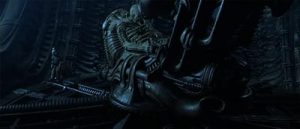
The sane world, the waking world is represented by Nostromo (Joseph Conrad reference duly noted); the nightmare world comes from the twisted imagination of painter H. R. Giger, whose biomechanical, Freudian dream imagery is represented by the Alien itself as well as the doomed spaceship (piloted by an unrelated other alien species) where the trouble begins. (see amusing exchange with Johnny Sweatpants.) (Hiring one designer to create the Nostromo world and a completely different one — an insane Swiss painter — to design the alien portions of the movie was another brilliant Scott move.) Giger’s work makes one recognize that the movie’s title is an adjective as well as a noun: the unsettling, Lovecraftian strangeness of it all could be the most important element of the movie’s visual texture.
3) Perfection
Here’s where I throw in the towel because there just isn’t space to even list (let alone elaborate on) the elements in the movie that reach such incredibly high levels of quality, meticulousness and innovation. The photography (Derek Wadsworth BSC); the editing (Terry Rawlings); the music (best Jerry Goldsmith score ever, plus Scott brilliantly replaced Goldsmith’s “closing theme” with the second movement of Howard Hanson’s “Symphony #2 ‘Romantic'”), The modelmaking (Martin Bower, fresh off Space: 1999); the visual effects (Brian Johnson, also from Space: 1999 and about to join ILM and win Oscars for The Empire Strikes Back the following year); the superlative, Royal Shakespeare Company-level acting (Tom Skerrit, Sigourney Weaver, John Hurt, Ian Holm, Veronica Cartwright, Yaphet Kotto, Harry Dean Stanton); I could go on. David Fincher (who made the underrated Alien 3 as his first feature) called Alien “one of the five most perfect movies ever made,” and Fincher is no stranger to the concept of technical artistry as the major armature for superior filmmaking. A lot of Robert Altman types “disapprove” of this kind of “slick, overdone” technical skill but it’s just jealousy: they know they can’t do it, so they insist it’s not important.
What is important (returning to my opening point) is the zen wholeness of the work of art, as exemplified here. It doesn’t “mean” anything (although it does, actually, and dozens of critical essays and academic readings have found intricate layers of significance in this movie including Freudian dream imagery, Marxist social commentary, gender themes, ’70s anti-corporate messages, morality tales etc.); it’s just extraordinarily superb, and that’s the whole ball game; but there’s nothing extraneous to the central task of scaring the audience, and if we didn’t all celebrate the wondrousness of that, we wouldn’t be here on Horrorthon to begin with.
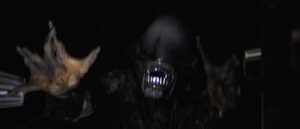
[* As promised, the “flaw” I mentioned above: when Ripley is re-activating Ash, she moves his head after re-connecting the fiber-optics and the movie switches from “prop head” to “Ian Holm’s head poking through a hole.” It’s a mis-matched cut! You would think Scott would cover the mismatch by inserting a reaction shot, but he doesn’t. In the director’s commentary, at that moment, Scott rather defensively says, “Not a bad cut.” But it is!]
Wednesday, October 10th, 2007 • Horrorthon Posts / Horrorthon Reviews
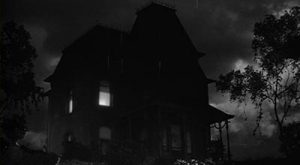
You know what I think? I think that we’re all in our private traps, clamped in them, and none of us can ever get out. We scratch and claw, but only at the air, only at each other, and, for all of it, we never budge an inch.
1960 (*****)
My Horrorthon “Masterpiece Series” continues with Psycho (1960), the modestly-budgeted, small-scaled black-and-white chiller that is often called “the greatest horror film ever made.” (I won’t get into whether it is or not, since that kind of statistical, Almanac-style critique is especially tedious in the popular arts, where the best examples warp and re-define the criteria in a way that makes choosing a single “best” example nearly impossible.) While it may or may not be “the best,” Psycho is without question a movie that has influenced the genre so overwhelmingly that nearly every horror/thriller film made since owes a debt to it.
Director Alfred Hitchcock is one of several artists whose career peaked almost exactly halfway through, with a series of two or three masterpieces in a row: I’m thinking of the Beatles with Sgt. Pepper (1967) and The Beatles (The “White Album”) (1968) or Stanley Kubrick with Dr. Strangelove (1964), 2001: A Space Odyssey (1968) and A Clockwork Orange (1973) or Woody Allen with Annie Hall (1977) and Manhattan (1979). When this happens, the individual works in question have almost a diamond-like precision, as if the artist has finally come to understand precisely what he or she is really doing, in the grandest sense, and is therefore able to focus on the task of making a perfect example of their art. Psycho — which followed Vertigo (1958) and North by Norhwest (1959) — is no exception.
Like John Woo and Paul Verhoven, Hitchcock is one in a long series of foreign directors who were lured to America by producers curious to discover how their intriguing or innovative techniques would translate into a more high-budgeted, glamorous environment with big stars. David O. Selznick famously gave Hitchcock a chance at his first American production with Rebecca (1940), which was nominated for 11 Oscars and won 2 (including Best Picture). Thus began a Spielberg-like winning streak of financial and critical successes that made Hitchcock both the most popular and one of the most critically praised directors of his time. However, twenty years after Rebecca, following several complex, high-budget Technicolor productions in a row, Hitchcock famously decided to strip away nearly all of the cumbersome filmmaking apparatus he had developed and return to the simple, direct black-and-white techniques he began with in England, before he migrated from the British filmmaking culture to Hollywood.
Putting together a small, efficient production crew culled mostly from his anthology TV series (Alfred Hitchcock Presents), Hitchcock bought a mediocre Robert Bloch novel called Psycho and hired established screenwriter Joseph Stefano to simplify and re-shape its story into a lean, clear narrative. Every other element of his filmmaking process was correspondingly cleaned, simplified, and pared down, including the contributions of his favorite long-time collaborators: Just like Spielberg always uses John Williams music and ILM (even on Schindler’s List), Hitchcock always used composer Bernard Herrmann (whose first movie was Citizen Kane and last movie was Taxi Driver — beat that!) and title designer/visual consultant Saul Bass, but even those two Hitchcock fixtures got into the minimalist spirit of the project: Herrman created a score performed entirely on strings, and Bass built the movie’s title sequence around simplified patterns of sweeping white and black lines that shimmer and oscillate unnervingly, foreshadowing the dark madness at the core of the story.
Psycho is deceptively simple, like the best work of Matisse or Corbusier; it has a handful of characters and settings and can be summarized in two or three sentences. But the movie has tremendous depth. In fact, it may be one of the deepest, most complex works of art ever created; hundreds of critical essays over the decades (including Donald Spoto’s book-length scene-by-scene analysis) have examined and explored the piece through the lenses of Freudian symbolism, surrealism, and pictorial and narrative theory. This is the only movie I know of to not just be remade, but remade shot-for-shot (by Gus Van Sant in 1998), which is a testament to the precision of the filmmaking; the camera moves and the cuts and sound effects are so completely integrated into the story that you arguably cannot change a stroke without it not being Psycho any more. I promise not to delve too deeply into the various post-structuralist readings and abstruse theories (even though I love that kind of thing), but suffice it to say that the reservoirs of meaning in the film seem nearly as bottomless as the central blackness of the story is impenetrable; despite its modest story, Psycho appears to provide a fleeting glimpse into the darkest and vastest abysses of the universe.

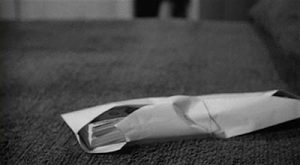
Marion Crane (Janet Leigh) is a clerk at a Phoenix, AZ real estate office with a hunky, divorced boyfriend named Sam (John Gavin) whom she routinely meets for trysts on her lunch breaks. Sam, a hardware-store owner in nearby Fairvale, CA, cannot marry her due to his own crippling financial problems (alimony and family debt); the couple is clearly suffering from the impropriety of their arrangement and the strain of his constant payments to his ex-wife, creditors and other “people who aren’t there.” Sam is not the only one suffering: “They also pay who meet in hotel rooms,” Marion points out (and, later, she will discover the real truth of that statement). (“People who aren’t there” is a meaningful phrase too, as the viewer will eventually learn.) Marion is a realistic case study; an ordinary law-abiding citizen introduced at the exact moment that she impulsively and unexpectedly slips over the edge into criminal behavior. A large sum of cash is entrusted to her for deposit in the company’s bank account, and the first half-hour of the movie (shot in blindingly bright, cloudless broad daylight) follows her step by step as she hesitatingly goes through the motions of stealing the money and leaving town with it, enacting a not-very-well-thought-out plan to bring the cash to Sam and free him from his wage-slave financial prison so that they can run away together.
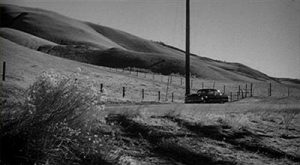
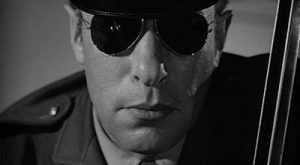
I don’t know what to say about this half-hour opening sequence without getting into superlatives. Not only does Hitchcock gently ratchet up the tension (As Marion drives farther away from town and deeper into trouble, she hears the imaginary voices of Sam and her co-workers as they reluctantly conclude that she has stolen the money) and broaden and darken the visual landscape during her relentless drive North by Northwest, but the road she is traveling and the people she meets (a suspicious California Highway Patrolman; a fast-talking used-car salesman who lets her trade vehicles but is visibly mistrustful) are elements in a foreboding, primal American landscape that make it impossible not to universalize and emotionally connect with Marion’s story, on several levels at once: she is a white-collar fugitive on the run, driving away from dangers and problems that she obviously (and knowingly) cannot escape, but, beyond that, Marion is on the wrong road and Hitchcock is making sure you understand that this road leads to a place she really should not go, and you find yourself increasingly wishing that she change her mind and turn back. But she never turns back, and day turns into night; clear weather turns into violent rain that somehow causes her to make a wrong turn (although it’s never clear when the wrong turn occurs) and soon she is off the main highway, lost and tired and looking for a place to spend the night.
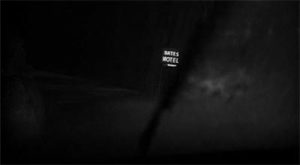
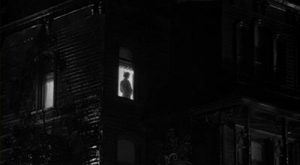


The Bates Motel, where all 12 rooms are vacancies — since “they moved the highway away,” as young proprietor Norman Bates (Anthony Perkins) explains — looms out of the rain like a deadly, mythic terminus. Marion finds the place deserted, but honking her horn summons Bates down from the gothic house that stands behind the cabins, where a silhouetted figure paces behind a solitary lit window. (Every image from this part of the movie has become so indelible and iconic that, to a modern viewer, Marion seems to have walked into a famous painting.) Bates invites Marion to join him for a late supper (which he brings down from the house), but his hospitality causes a bitter argument with his mother (the figure in the window) which Marion overhears.
After she hides the stolen money, Marion and Norman sit down in the motel parlor, which is decorated with stuffed birds (this is Bates’ hobby), and have one of the most exhaustively analyzed conversations in cinema (partially quoted above) in which Bates talks movingly about being trapped in the motel business due to his elderly and infirm mother; Marion sympathizes with his cruel treatment, while apologizing for intruding, and unexpectedly begins talking about the “private trap” she’s stepped into. Bates is offended at her suggestion that his mother be institutionalized, but ultimately agrees that his situation is unacceptable. The two clearly like each other, and communicate in a compelling and meaningful way; the conversation apparently convinces Marion to face up to what she’s done, reverse her plans and drive all the way back to Phoenix the next morning, after a shower and a good night’s sleep. (After she’s returned to her room, Norman reveals his boyish prurient interest in her by uncovering a spy-hole through which he can watch her undress.) Then, forty-six minutes into the movie, Marion gets into the shower and it’s the last thing she ever does.


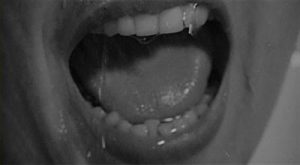

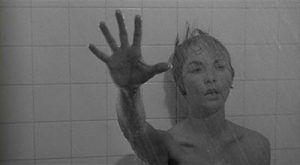
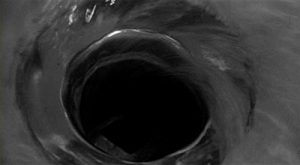
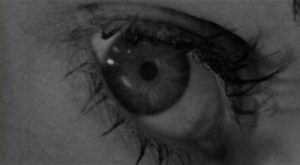
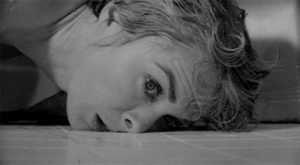
The murder scene (which comes out of nowhere) is justifiably famous; probably the most famous murder in film history. These days, such shocking twists are commonplace, but in 1960, nobody in the audience could possibly have expected the main character to be violently murdered less than halfway through the movie. There are scores of essays and analyses of the “shower sequence” that do a far better job than I ever could explaining the music, the cutting and the eye/drain/water/blood/curtain symbolism; suffice it to say that the metaphysics does not in any way impede the pure shock value and terror of the scene; when it’s over, and Norman is now, suddenly, the main character (trying desperately to cover up his mother’s crime) we have gone through the looking glass into an inverted nightmare world. The remaining hour of the movie — as Sam returns to the story, investigating Marion’s disappearance along with her sister (Vera Miles) and a private detective (Martin Balsam) hired by the Phoenix realtor — never quite matches the intense brilliance of the portion I’ve described in such detail, but there are several more twists to come, including a final shocker that’s about as good as any twist ending the genre has ever seen.
Is Psycho, like Roy Hobbs, “the best there ever was”? Maybe and maybe not, as I said up top (and I reiterate my distaste with the question). It may not even be Hitchcock’s primary masterpiece; that’s probably Vertigo (which isn’t a horror film at all; more of a traditional mystery/suspense thriller). But Psycho singlehandedly invents, exemplifies and transcends the slasher genre, and it would be difficult to find a more flawless example of the form. The Bates Motel anchors down a corner of the nightmare landscape deep in all of our subconscious minds; it’s the place you go when the storm drives you off the main road into chaos and madness; although it may look like a simple pair of buildings in the California desert, it’s really a gateway into ultimate darkness, and if you go there, you’ll never come back.